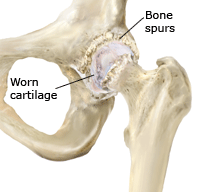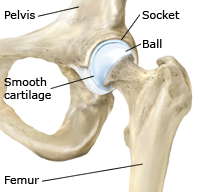Arthritis
Knee Arthritis and the Treatment of Pain
Osteoarthritis, or degenerative joint disease, is the most common form of arthritis and results in the loss of the articular joint cartilage (the cartilage coating the ends of bones). The loss of this cartilage is most commonly due to one's genetic makeup. Old trauma or injury is another cause of degenerative joint disease and along with genetics contributes to early development of disabling arthritis. Other causes of articular cartilage destruction or joint disease include avascular necrosis (loss of the blood supply of the underlying bone), post traumatic degenerative joint disease, and inflammatory conditions (including rheumatoid arthritis, ankylosing spondylitis, psoriatic arthritis).



Articular cartilage cushions the joint during activities and provides smooth, pain free motion of the joint. The loss of the cartilage (via the death of cartilage cells) leaves areas of the bone uncovered leading to bone on bone contact. This contact and pressure change results in inflammation, which leads to pain, swelling, and stiffness. We are currently working on ways to prevent cartilage cell death and ways to restore articular cartilage through stem cell and genetic research. Unfortunately, we are many decades away from effective treatments, and knee replacement remains the treatment of choice for end stage arthritis.

In the x-ray, note the loss of the “cartilage cushion” on the end of the bone, seen as the bones touching or "bone-on-bone." This loss of cartilage coating the bone is arthritis.
The initial treatment of arthritis is through medications designed to decrease pain and inflammation. These medications include Acetaminophen (Tylenol), Aspirin, Ibuprofen (Motrin or Advil), Naproxen (Naprosyn or Aleve), Diclofenac (Voltaren), and Cox 2 Inhibitors (Celebrex). Other early treatments include injections such as corticosteroids and viscosupplementation injections such as Synvisc. Once these treatments are exhausted and the patient has significant activity limiting pain, surgical treatments can be considered.
Several surgical options exist in the treatment of arthritis of the knee. These include total knee replacement, knee resurfacing, and partial knee replacement. A lengthy conversation with your surgeon after a thorough examination and history is important to determine and understand which procedure is appropriate for you.
Hip Arthritis and the Treatment of Hip Pain
Osteoarthritis, or degenerative joint disease, is the most common form of arthritis and results in the loss of the articular joint cartilage (the cartilage coating the ends of bones). The loss of articular joint cartilage or cartilage cells is most commonly due to one's genetic makeup. Old trauma or injury is another cause of degenerative joint disease and along with genetics contributes to early development of disabling arthritis.

Articular cartilage cushions the joint during activities and provides smooth, pain free motion of the joint. The loss of the cartilage (via the death of cartilage cells) leaves areas of the bone uncovered leading to bone on bone contact. This contact and pressure change results in inflammation, which leads to pain, swelling, and stiffness. We are currently working on ways to prevent cartilage cell death and ways to restore articular cartilage through stem cell and genetic research. Unfortunately, we are many decades away from effective treatments and hip replacement or resurfacing remains the treatment of choice for end stage arthritis.

Other causes of articular cartilage or joint disease include avascular necrosis (loss of the blood supply of the underlying bone), post traumatic degenerative joint disease, and inflammatory conditions (including rheumatoid arthritis, ankylosing spondylitis, psoriatic arthritis).
The initial treatment of arthritis is through medications designed to decrease pain and inflammation. These medications include Acetaminophen (Tylenol), Aspirin, Ibuprofen (Motrin or Advil), Naproxen (Naprosyn), Diclofenac (Voltaren), and cox 2 inhibitors (Celebrex). Other early treatments include injections such as corticosteroids and viscosupplementation injections such as Synvisc. Once these treatments are exhausted and the patient has significant activity limiting pain, surgical treatments can be considered.

